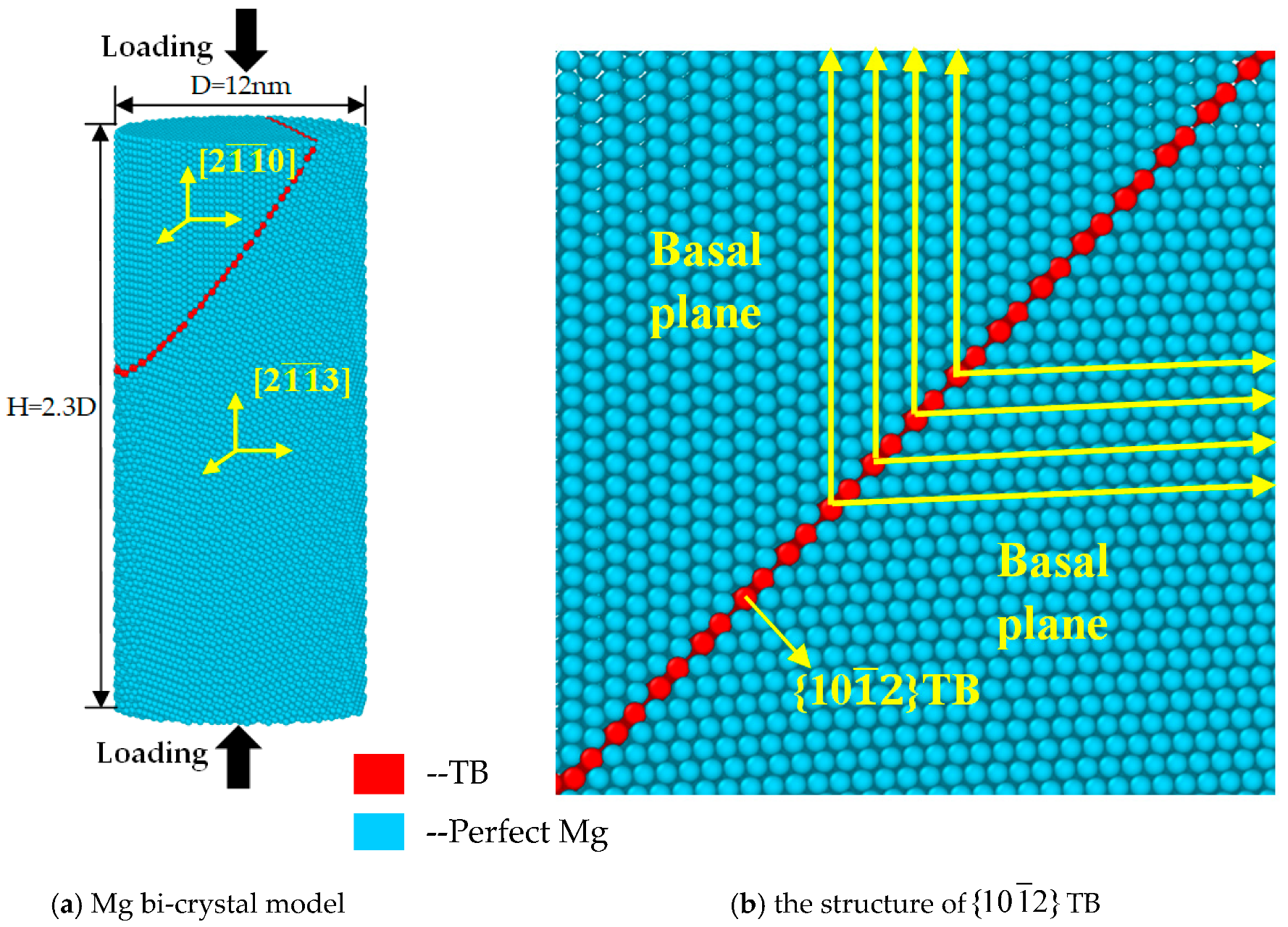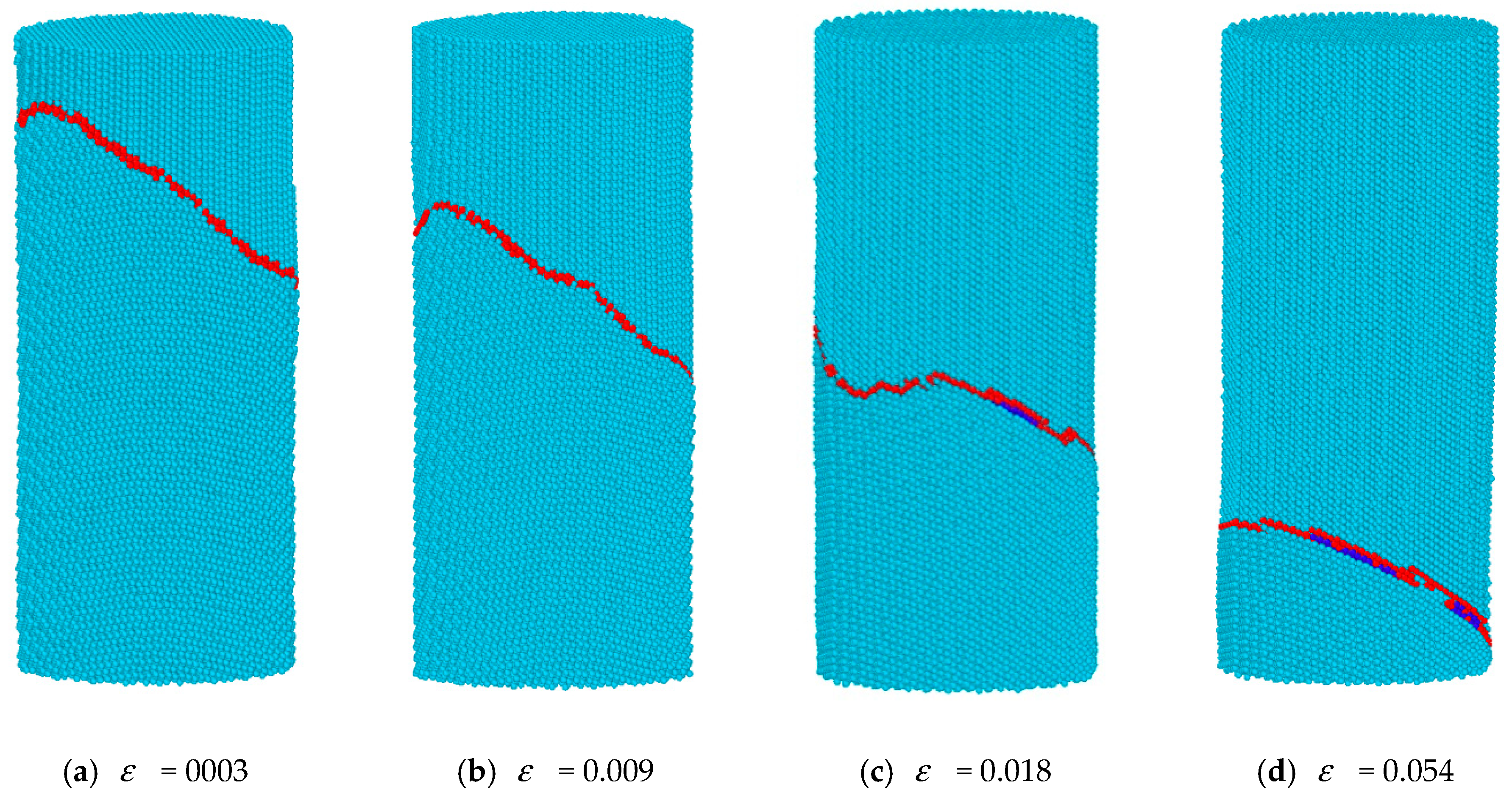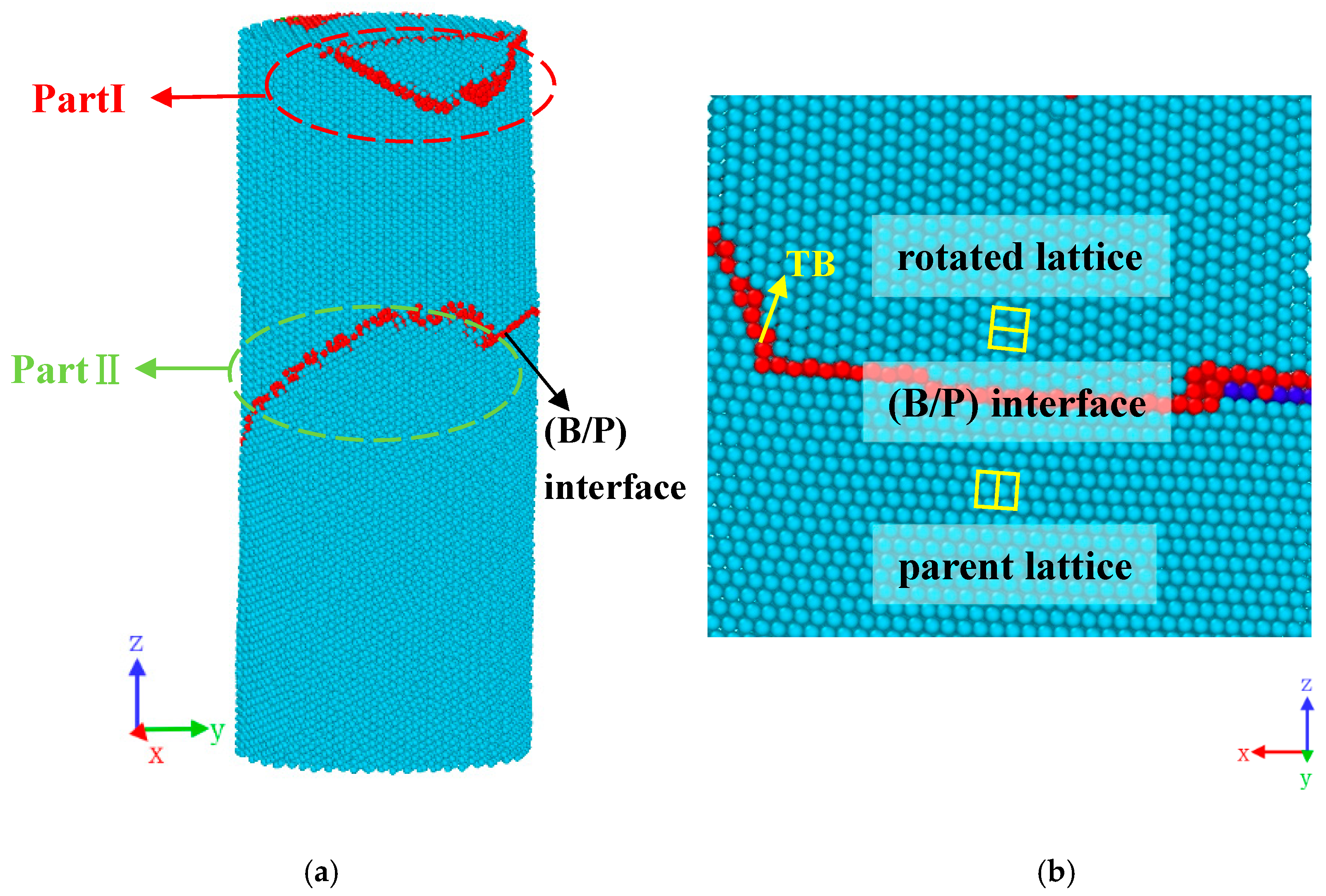Plastic Deformation Behavior of Bi-Crystal Magnesium Nanopillars with a {1012} Twin Boundary under Compression: Molecular Dynamics Simulations
Abstract
1. Introduction
2. Methodology
3. Simulation Results
4. Discussion
5. Conclusions
- The initial plastic deformation was dominated by the migration of the twin boundary (TB), and there is a mechanism for basal/prismatic transformation.
- Obvious stress fluctuation during the plastic deformation was caused by competition between TB migration and basal slip. Moreover, pyramidal slip was observed.
- At a higher strain level ( = 0.104), the , twin formation was observed due to the lattice reorientation, and it grew rapidly.
Author Contributions
Funding
Conflicts of Interest
References
- Toghyani, S.; Khodaei, M. Fabrication and characterization of magnesium scaffold using different processing parameters. Mater. Res. Express 2018, 5, 035407. [Google Scholar] [CrossRef]
- Rks, R.; Harandi, S.E. Resistance of Magnesium Alloys to Corrosion Fatigue for Biodegradable Implant Applications: Current Status and Challenges. Materials 2017, 10, 1316. [Google Scholar]
- Safia, A.; John, W.; Yang, L. Numerical Modelling of Effects of Biphasic Layers of Corrosion Products to the Degradation of Magnesium Metal In Vitro. Materials 2018, 11, 1. [Google Scholar]
- Venturi, F.; Calizzi, M.; Bals, S.; Perkisas, T.; Pasquini, L. Self-assembly of gas-phase synthesized magnesium nanoparticles on room temperature substrates. Mater. Res. Express 2014, 2, 015007. [Google Scholar] [CrossRef]
- Dong, S.; Yu, Q.; Jiang, Y.; Dong, J.; Wang, F.; Ding, W. Electron backscatter diffraction observations of twinning–detwinning evolution in a magnesium alloy subjected to large strain amplitude cyclic loading. Mater. Des. 2015, 65, 762–765. [Google Scholar] [CrossRef]
- Ni, C.; Ding, H.; Jin, X. Super-plasticity via secondary twinning in magnesium nanowire revealed by molecular dynamics simulations. Comput. Mater. Sci. 2016, 111, 163–174. [Google Scholar] [CrossRef]
- Jian, W. Twinning nucleation mechanisms in hexagonal-close-packed crystals. Acta Mater. 2009, 57, 5521–5530. [Google Scholar]
- Christian, J.W.; Mahajan, S. Deformation twinning. Prog. Mater. Sci. 1995, 39, 1–157. [Google Scholar] [CrossRef]
- El Kadiri, H.; Barrett, C.D.; Wang, J.; Tomé, C.N. Why are twins profuse in magnesium? Acta Mater. 2015, 85, 354–361. [Google Scholar] [CrossRef]
- Zhu, H.; Liu, S.; Liu, Z.; Li, D. Tailoring the stability of mathContainer Loading Mathjax twins in magnesium with solute segregation at the twin boundary and strain path control. Comput. Mater. Sci. 2018, 152, 113–117. [Google Scholar] [CrossRef]
- Yu, Q.; Qi, L.; Chen, K.; Mishra, R.K.; Li, J.; Minor, A.M. The nanostructured origin of deformation twinning. Nano Lett. 2012, 12, 887–892. [Google Scholar] [CrossRef] [PubMed]
- Wu, L.; Jain, A.; Brown, D.W.; Stoica, G.M.; Agnew, S.R.; Clausen, B.; Fielden, D.E.; Liaw, P.K. Twinning–detwinning behavior during the strain-controlled low-cycle fatigue testing of a wrought magnesium alloy, ZK60A. Acta Mater. 2008, 56, 688–695. [Google Scholar] [CrossRef]
- Proust, G.; Tomé, C.N.; Jain, A.; Agnew, S.R. Modeling the effect of twinning and detwinning during strain-path changes of magnesium alloy AZ31. Int. J. Plast. 2009, 25, 861–880. [Google Scholar] [CrossRef]
- Chino, Y.; Kimura, K.; Mabuchi, M. Deformation characteristics at room temperature under biaxial tensile stress in textured AZ31 Mg alloy sheets. Acta Mater. 2009, 57, 1476–1485. [Google Scholar] [CrossRef]
- Matsubara, K.; Kimizuka, H.; Ogata, S. Formation of mathContainer Loading Mathjax twins from I 1 -type stacking faults in Mg: A molecular dynamics study. Comput. Mater. Sci. 2016, 122, 314–321. [Google Scholar] [CrossRef]
- Capolungo, L.; Beyerlein, I.J. Nucleation and stability of twins in hcp metals. Phys. Rev. B 2008, 78, 1436–1446. [Google Scholar] [CrossRef]
- Yoo, M.H.; Lee, J.K. Deformation twinning in h.c.p. metals and alloys. Philos. Mag. A 1991, 63, 987–1000. [Google Scholar] [CrossRef]
- Wang, J.; Beyerlein, I.J.; Tomé, C.N. An atomic and probabilistic perspective on twin nucleation in Mg. Scr. Mater. 2010, 63, 741–746. [Google Scholar] [CrossRef]
- Wang, J.; Hoagland, R.G.; Hirth, J.P.; Capolungo, L.; Beyerlein, I.J.; Tomé, C.N. Nucleation of a twin in hexagonal close-packed crystals. Scr. Mater. 2009, 61, 903–906. [Google Scholar] [CrossRef]
- Tu, J.; Zhang, S. On the twinning growth mechanism in hexagonal close-packed metals. Mater. Des. 2016, 96, 143–149. [Google Scholar] [CrossRef]
- Serra, A.; Bacon, D.J. A new model for twin growth in hcp metals. Philos. Mag. A 1996, 73, 333–343. [Google Scholar] [CrossRef]
- Guo, Y.F.; Xu, S.; Tang, X.Z.; Wang, Y.S. Twinnability of hcp metals at the nanoscale. J. Appl. Phys. 2014, 115, 224902. [Google Scholar] [CrossRef]
- Guo, Y.F.; Xu, S.; Tang, X.Z.; Wang, Y.S.; Yip, S. Size effect on deformation twinning at the nanoscale in hcp metals. Physics 2013, 21, 29–35. [Google Scholar]
- Xu, S.; Guo, Y.-F. Molecular Dynamics Study on the Effect of Temperature on Deformation Mechanism of Magnesium Nanopillars with Square Cross-Sections. Nanosci. Nanotechnol. Lett. 2016, 8, 603–606. [Google Scholar] [CrossRef]
- Hazeli, K.; Cuadra, J.; Streller, F.; Barr, C.M.; Taheri, M.L.; Carpick, R.W.; Kontsos, A. Three-dimensional effects of twinning in magnesium alloys. Scr. Mater. 2015, 100, 9–12. [Google Scholar] [CrossRef]
- Somekawa, H.; Singh, A.; Schuh, C.A. Effect of twin boundaries on indentation behavior of magnesium alloys. J. Alloys Compd. 2016, 685, 1016–1023. [Google Scholar] [CrossRef]
- Liu, G.; Xin, R.; Liu, F.; Liu, Q. Twinning characteristic in tension of magnesium alloys and its effect on mechanical properties. Mater. Des. 2016, 107, 503–510. [Google Scholar] [CrossRef]
- Gu, C.F.; Toth, L.S.; Hoffman, M. Twinning effects in a polycrystalline magnesium alloy under cyclic deformation. Acta Mater. 2014, 62, 212–224. [Google Scholar] [CrossRef]
- Zeng, R.; Han, E.; Ke, W.; Dietzel, W.; Kainer, K.U.; Atrens, A. Influence of microstructure on tensile properties and fatigue crack growth in extruded magnesium alloy AM60. Int. J. Fatigue 2010, 32, 411–419. [Google Scholar] [CrossRef]
- Timár, G.; Barnett, M.R.; Fonseca, J.Q.D. Discontinuous yielding in wrought magnesium. Comput. Mater. Sci. 2017, 132, 81–91. [Google Scholar] [CrossRef]
- Wu, P.D.; Guo, X.Q.; Qiao, H.; Lloyd, D.J. A constitutive model of twin nucleation, propagation and growth in magnesium crystals. Mater. Sci. Eng. A 2015, 625, 140–145. [Google Scholar] [CrossRef]
- Song, H.Y.; Li, Y.L. Effect of twin boundary spacing on deformation behavior of nanotwinned magnesium. Phys. Lett. A 2012, 376, 529–533. [Google Scholar] [CrossRef]
- Feng, H.; Fang, Q.H.; Liu, B.; Liu, Y.; Liu, Y.W.; Wen, P.H. Nucleation and growth mechanisms of nanoscale deformation twins in hexagonal-close-packed metal magnesium. Mech. Mater. 2017, 109, 26–33. [Google Scholar] [CrossRef]
- Li, B.; Ma, E. Zonal dislocations mediating twinning in magnesium. Acta Mater. 2009, 57, 1734–1743. [Google Scholar] [CrossRef]
- Mei, H.; Xu, S.; Liu, L.; She, W.; Li, J.; Fu, Z. Effect of twin boundary on the initial yield behavior of magnesium nanopillars under compression: Molecular dynamics simulations. Mater. Res. Express 2018, 5, 026513. [Google Scholar] [CrossRef]
- Zhou, L.; Guo, Y.F. Dislocation-Governed Plastic Deformation and Fracture Toughness of Nanotwinned Magnesium. Materials 2015, 8, 5250–5264. [Google Scholar] [CrossRef] [PubMed]
- Ovid’Ko, I.A.; Sheinerman, A.G. Mechanical properties of nanotwinned metals: A review. Rev. Adv. Mater. Sci. 2016, 44, 1–25. [Google Scholar]
- Lu, L.; You, Z. Plastic deformation mechanisms in nanotwinned metals. Acta Metall. Sin. 2014, 50, 129–136. [Google Scholar]
- Kim, D.H.; Ebrahimi, F.; Manuel, M.V.; Tulenko, J.S.; Phillpot, S.R. Grain-boundary activated pyramidal dislocations in nano-textured Mg by molecular dynamics simulation. Mater. Sci. Eng. A 2011, 528, 5411–5420. [Google Scholar] [CrossRef]
- Liu, Y.; Li, N.; Kumar, M.A. Experimentally quantifying critical stresses associated with basal slip and twinning in magnesium using micropillars. Acta Mater. 2017, 135, 411–421. [Google Scholar] [CrossRef]
- Serra, A.; Bacon, D.J. Interaction of a moving twin boundary with perfect dislocations and loops in a hcp metal. Philos. Mag. 2010, 90, 845–861. [Google Scholar] [CrossRef]
- Fan, H.D.; Aubry, S.; Arsenlis, A.; EL-Awady, J.A. The role of twinning deformation on the hardening response of polycrystalline magnesium from discrete dislocation dynamics simulations. Acta Mater. 2015, 92, 126–139. [Google Scholar] [CrossRef]
- Fan, H.D.; Aubry, S.; Arsenlis, A.; EL-Awady, J.A. Grain size effects on dislocation and twinning mediated plasticity in magnesium. Scr. Mater. 2016, 112, 50–53. [Google Scholar] [CrossRef]
- El-Awady, J.A.; Fan, H.D.; Hussein, A.M. Advances in Discrete Dislocation Dynamics Modeling of Size-Affected Plasticity. In Multiscale Materials Modeling for Nanomechanics; Springer: Cham, Switzerland, 2016; pp. 337–371. [Google Scholar]
- Cai, W.; Bulatov, V.V. Mobility laws in dislocation dynamics simulations. Mater. Sci. Eng. A 2004, 387, 277–281. [Google Scholar] [CrossRef]
- Weinberger, C.R.; Cai, W. Orientation-Dependent Plasticity in Metal Nanowires under Torsion: Twist Boundary Formation and Eshelby Twist. Nano Lett. 2010, 10, 139–142. [Google Scholar] [CrossRef] [PubMed]
- Mayama, T.; Ohashi, T.; Higashida, K. Influence of Grain Boundary on Activation of Slip Systems in Magnesium: Crystal Plasticity Analysis. Mater. Sci. Forum 2010, 654–656, 695–698. [Google Scholar] [CrossRef]
- Hong, S.G.; Park, S.H.; Chong, S.L. Role of twinning characteristics in the deformation behavior of a polycrystalline magnesium alloy. Acta Mater. 2010, 58, 5873–5885. [Google Scholar] [CrossRef]
- Liu, X.Y.; Ohotnicky, P.P.; Adams, J.B.; Rohrer, C.L.; Hyland, R.W., Jr. Anisotropic surface segregation in Al–Mg alloys. Surf. Sci. 1997, 373, 357–370. [Google Scholar] [CrossRef]
- Tang, Y.; El-Awady, J.A. Formation and slip of pyramidal dislocations in hexagonal close-packed magnesium single crystals. Acta Mater. 2014, 71, 319–332. [Google Scholar] [CrossRef]
- Sun, D.Y.; Mendelev, M.I.; Becker, C.A.; Kudin, K.; Haxhimali, T.; Asta, M.; Hoyt, J.J.; Karma, A.; Srolovitz, D.J. Crystal-melt interfacial free energies in hcp metals: A molecular dynamics study of Mg. Phys. Rev. B 2006, 73, 024116. [Google Scholar] [CrossRef]
- Plimpton, S. Fast Parallel Algorithms for Short-Range Molecular Dynamics; Academic Press Professional, Inc.: San Diego, CA, USA, 1995; pp. 1–19. [Google Scholar]
- Honeycutt, J.D.; Andersen, H.C. Molecular dynamics study of melting and freezing of small Lennard-Jones clusters. J. Phys. Chem. 1987, 91, 4950–4963. [Google Scholar] [CrossRef]
- Stukowski, A. Visualization and analysis of atomistic simulation data with OVITO-the Open Visualization Tool. Model. Simul. Mater. Sci. Eng. 2010, 18, 2154–2162. [Google Scholar] [CrossRef]
- Agnew, S.R.; Duygulu, Ö. Plastic anisotropy and the role of non-basal slip in magnesium alloy AZ31B. Int. J. Plast. 2005, 21, 1161–1193. [Google Scholar] [CrossRef]
- Mishra, R.K. Plasticity of Crystals. Aeronaut. J. 1950, 54, 353–719. [Google Scholar]
- Ando, D.; Koike, J.; Sutou, Y. Relationship between deformation twinning and surface step formation in AZ31 magnesium alloys. Acta Mater. 2010, 58, 4316–4324. [Google Scholar] [CrossRef]
- Nan, X.L.; Wang, H.Y.; Zhang, L.; Li, J.B.; Jiang, Q.C. Calculation of Schmid factors in magnesium: Analysis of deformation behaviors. Scr. Mater. 2012, 67, 443–446. [Google Scholar] [CrossRef]
- Wu, B.L.; Zhao, Y.H.; Du, X.H.; Zhang, Y.D.; Wagner, F.; Esling, C. Ductility enhancement of extruded magnesium via yttrium addition. Mater. Sci. Eng. A 2010, 527, 4334–4340. [Google Scholar] [CrossRef]








| Deformation Modes | Slip Plane | Slip Direction | SF |
|---|---|---|---|
| TB migration | 0.43 | ||
| basal slip | 0.38 |
| Deformation Modes | Slip Plane | Slip Direction | SF |
|---|---|---|---|
| TB migration | 0.34 | ||
| basal slip | 0 | ||
| new twin | 0.37 |
© 2019 by the author. Licensee MDPI, Basel, Switzerland. This article is an open access article distributed under the terms and conditions of the Creative Commons Attribution (CC BY) license (http://creativecommons.org/licenses/by/4.0/).
Share and Cite
Yang, X.; Xu, S.; Chi, Q. Plastic Deformation Behavior of Bi-Crystal Magnesium Nanopillars with a {1012} Twin Boundary under Compression: Molecular Dynamics Simulations. Materials 2019, 12, 750. https://doi.org/10.3390/ma12050750
Yang X, Xu S, Chi Q. Plastic Deformation Behavior of Bi-Crystal Magnesium Nanopillars with a {1012} Twin Boundary under Compression: Molecular Dynamics Simulations. Materials. 2019; 12(5):750. https://doi.org/10.3390/ma12050750
Chicago/Turabian StyleYang, Xiaoyue, Shuang Xu, and Qingjia Chi. 2019. "Plastic Deformation Behavior of Bi-Crystal Magnesium Nanopillars with a {1012} Twin Boundary under Compression: Molecular Dynamics Simulations" Materials 12, no. 5: 750. https://doi.org/10.3390/ma12050750
APA StyleYang, X., Xu, S., & Chi, Q. (2019). Plastic Deformation Behavior of Bi-Crystal Magnesium Nanopillars with a {1012} Twin Boundary under Compression: Molecular Dynamics Simulations. Materials, 12(5), 750. https://doi.org/10.3390/ma12050750





